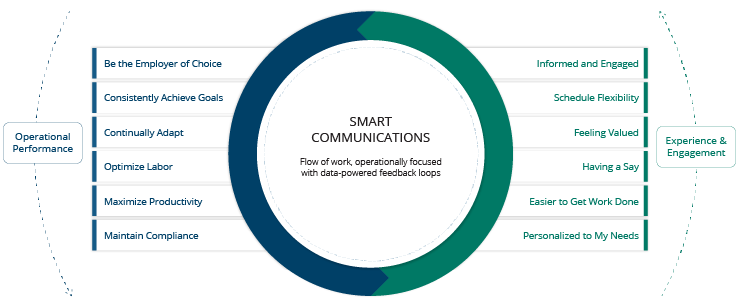Organisations today are operating in a time of accelerating change. This is due to multiple factors: the ever-changing effects of new technologies, industry trends, customer demands, and employee expectations. Whilst some turbulent events can be expected and accounted for, others can be more difficult to manage. This is especially true when businesses don’t have the appropriate tools to tackle the situation. The continued reverberations of COVID-19 brought to a boiling point the simmering needs of many deskless shift-based workers who were often on the front lines of the pandemic. It put a spotlight on the need for organisations to focus on employee experience to keep operations running and ensure employee well-being.
New realities require solutions, and modern workforce management may be exactly what your organisation needs to address them.
What Is Modern Workforce Management?
At its heart, modern workforce management is a discipline focused on optimizing business performance whilst treating workers as a valuable resource. Bridging the gap between desired business outcomes and employee expectations, modern workforce management provides consumer-grade tools to support your employees’ successes on the job no matter where and when work happens.

Let’s look at some workplace scenarios with notably modern problems and see just how modern workforce management can remedy the situation.
Scenario A
Company X is a manufacturer that has been dealing with “feast or famine” labour demands due to ongoing supply chain disruptions. Workers’ rosters are highly erratic as a result, with fluctuating periods of slow production and overwhelming demand.
The Old Solution
The company and workers alike would begrudgingly suffer along with these problems because of an inability to anticipate change and lack of training. This would lead to reduced income for workers during slow times and exhaustion and burnout in heavier times. Many workers would have to seek outside income to compensate for the difference, which then interfered with their availability. This led to mounting frustrations between workers and management and impacted the business’s bottom line due to the inability to manage labour costs and scale production based on demand.
The Modern Workforce Solution
Built-in AI capabilities can analyse previous labour-demand and supply-line fluctuation data and create predictable labour forecasting to prepare schedulers for rostering impacts. Rosters can be aligned with production and capacity levels. Employee data can be used to determine the best shifts based on availability, employee skill level, and union/compliance regulations. Digital algorithms can also be used to monitor employee overtime, ensuring that burnout doesn’t become an issue among employees. Micro training delivered at the time work happens through a familiar, easy to use mobile app helps prepare workers to be fluid and perform the task at hand, training workers in new skills, re-training team members needing extra details, and up-skilling workers in new talents.
Scenario B
Company Y is a retail store that has issues with communication between HQ, store managers, and workers regarding company directives, in-store displays, and setting up promotions. HQ directives frequently hit obstacles that are just ignored if they can’t be surmounted, and managers often have trouble getting workers to consistently follow through on instructions for brand compliance.
The Old Solution
HQ passed along a directive to managers to fire some of the less productive team members to motivate the other staff to get their act together. Managers implemented new training directives, but studies find such sessions tend to occur only once and most details end up completely forgotten by employees within six months.
The Modern Workforce Solution
A modern workforce management platform integrated with employee communications powered by real time data and analytics enables engagement through one business app accessed via computer and smartphone. Open channels eliminate classic “top down” communication that stifles the sharing of information and reinforces outdated hierarchies separating management from workers. This allows both direct and company-wide conversation, ensuring everyone is kept informed. Digital task management provides interactive checklists to ensure responsibilities are being carried out by all parties. Photo- and video-sharing capabilities not only allow for confirmation of fulfilled tasks but can also be used to explain and demonstrate new suggestions, clarify any difficulties that may arise, and collaborate on troubleshooting those issues.
Scenario C
Company Z is a utility company with a staff problem. Many of their workers have been leaving the company, new hires are disengaged, and attracting new talent has been very difficult. The workers who have given reasons for their departure cite issues with management, not feeling valued by the company, and the company’s lack of focus on work/life balance.
The Old Solution
Continue to look for new hires. Consider a few minor promotions and raises to retain select talent. Maybe a weekly free pizza lunch will improve morale?
The Modern Workforce Solution
Modern workforce management is designed to create a positive employee experience (the aggregated moments of interaction between employees and their organisations). Real-time workforce communication and collaboration between management and workers in the field by way of a consumer grade app can be used to share best practices, ask for help, and celebrate successes. Easy access to current operating procedures, visual examples, and troubleshooting guides help employees get their work done with confidence. And easy access to rosters and self-service shift swapping to plan for personal commitments and resolve last-minute conflicts gives employees control over their work/life balance. Lastly, checking the pulse of employee sentiment using real-time, personalized surveys about topics such as unplanned overtime and extended work hours goes a long way in showing workers that their feedback is valued and will be acted upon.
As you can see, modern workforce management provides a solution to issues both new and old. Employers have taken notice as well. Gartner anticipates that by 2025, 80% of large enterprises will have invested in workforce management solutions to support employee experience and/or digital workplace initiatives. Modern workforce management isn’t the solution of the future—it’s the solution of the now.
Visit our Modern Workforce Management Value Centre to learn more.




